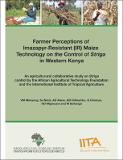| dc.description.abstract | For a long time, farmers in Nyanza and Western provinces in Kenya have had to deal
with the Striga problem. To most of them, Striga had become a way of life and they had
given up hope. Striga affects their mainstay crops, which are maize, sorghum, and millet.
After an extensive search for a solution, IR maize was developed. However, like all
new technologies, there is usually suspicion, especially from the end user. A study was
therefore conducted to find out the level of adoption and perception of farmers on this
technology. This study also sought to identify the constraints in the deployment of this
technology and arrest them on time. This report presents the findings of this study.
The stratified random sampling method was used to select 10 districts, 16 sublocations,
32 villages and 834 households. Two groups of farmers were investigated:
baseline and WeRATE farmers defined on the basis of the number of years of experience
with IR maize. A combination of techniques for data collection was used, including
literature review, interview of individual households and GPS recordings. Descriptive
statistics (frequency of events and means of parameters) were applied for data analysis.
Similarly, a binomial probit model was used to identify factors driving the perception
of the various households on the IR maize technology.
Findings from sampled households depict that most household heads are male. There
were about 26% of households headed by females. The level of education was low for
the heads of households and other members of farm families. Group membership was
high, especially among women. Most households (89%) had received extension visits
while 68% had attended field days, seminars and/or agricultural shows.
Farming activities were found to provide a substantial amount of income to most
households. Maize is the major food crop and a source of cash income to most households.
Farmers grow both local and improved (hybrid) maize varieties, but the productivity of
maize is low. There is a considerable gap between potential and actual maize yields.
Major factors constraining maize production include Striga infestation, drought, erratic
rainfall and low soil fertility. Striga is by far the major threat to livelihoods of smallholders.
Traditional methods of Striga control which include uprooting, burning and manuring
have proved to be ineffective. Although alternative technologies exist, they have not
been highly adopted and used, possibly because of lack of awareness.
Awareness of Striga and Striga control technologies was substantial among sampled
households. All were aware of IR maize technology followed by traditional practices and push-pull; the least known technology of Striga control was the intercropping
of legumes followed by cassava/Desmodium. Extension agents from the Ministry
of Agriculture and local NGOs were found to be the leading sources of information
and demonstrations on various Striga control technologies, including instructions/
guidelines required before the application of IR maize technology.
xiii
Farmers’ assessment of maize yields under different Striga control technologies
revealed that maize yields were higher where farmers used IR maize and push-pull
technologies. The least maize yields were observed in fields under traditional Striga
control technologies. Likewise, IR maize technology was superior in reducing Striga
population in the fields and control of both biotic and abiotic factors. There were
also some implications to the introduction of IR maize technology such as the change in
weeding times, capital requirement, carefulness in handling farming activities and
social implications such as group formation and emergency of credit societies.
The study identified critical ways to speed up the adoption of IR maize technology. The
need to establish proper diffusion channels was suggested as an important component
before full deployment of this technology. The need to bring IR maize seeds to stockists
near to farmers, increase cultivated plots to IR maize and increase IR maize kit and
more extension on the technology was highlighted as some of the ways to scale-up
the IR maize technology in the region. Other factors that contribute to the positive
perception of IR maize, thus to its diffusion and adoption, are farmer perceptions on
agronomy attributes of the technology, the number of extension visits, the exposure to
the technology, and the responsiveness of the technology to farmer needs. | en_US |

